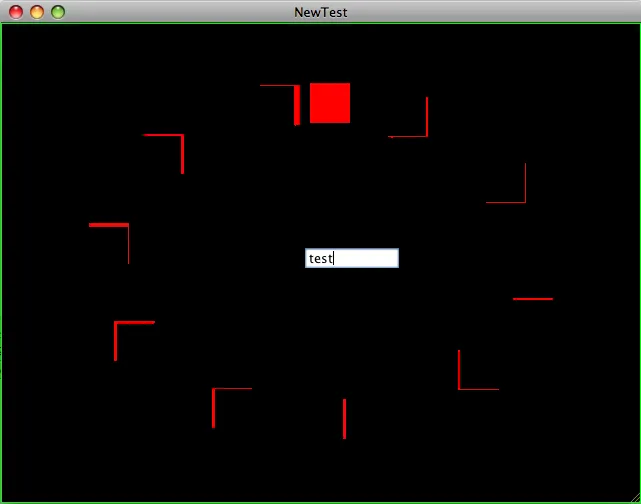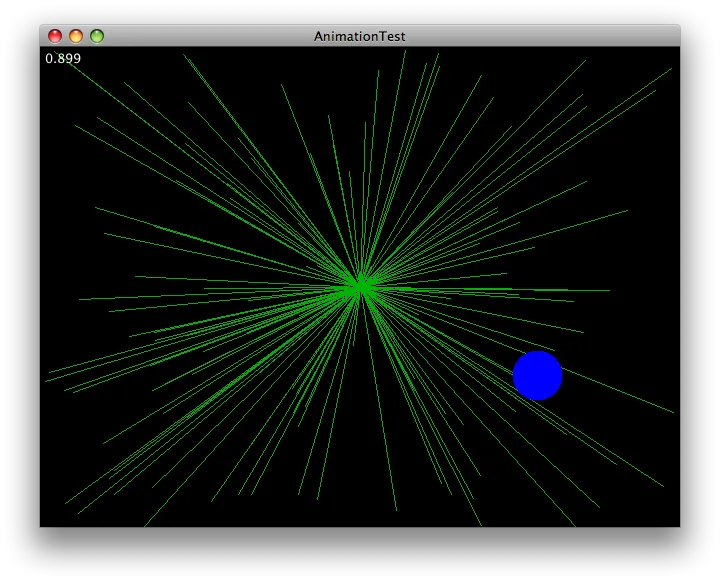有没有人尝试过使用Swing构建一个合适的多缓冲渲染环境,在此之上可以添加Swing用户界面元素?
在这种情况下,我在背景上绘制了一个动画的红色矩形。背景不需要每帧更新,因此我将其渲染到BufferedImage中,并仅重新绘制必要的部分以清除矩形的先前位置。请参见下面的完整代码,这扩展了@trashgod在先前的线程中提供的示例,在这里。
到目前为止,一切顺利;流畅的动画,低CPU使用率,没有闪烁。
然后我在JPanel中添加了一个JTextField(通过单击屏幕上的任何位置),并通过单击文本框内部对其进行了聚焦。现在在每个光标闪烁时都无法清除矩形的先前位置,请参见下面的图像。
我想知道为什么会发生这种情况(Swing不是线程安全的吗?图像异步绘制?)以及可能解决方案的方向。
这是在Mac OS 10.5,Java 1.6上的情况。
(来源:arttech.nl)
在这种情况下,我在背景上绘制了一个动画的红色矩形。背景不需要每帧更新,因此我将其渲染到BufferedImage中,并仅重新绘制必要的部分以清除矩形的先前位置。请参见下面的完整代码,这扩展了@trashgod在先前的线程中提供的示例,在这里。
到目前为止,一切顺利;流畅的动画,低CPU使用率,没有闪烁。
然后我在JPanel中添加了一个JTextField(通过单击屏幕上的任何位置),并通过单击文本框内部对其进行了聚焦。现在在每个光标闪烁时都无法清除矩形的先前位置,请参见下面的图像。
我想知道为什么会发生这种情况(Swing不是线程安全的吗?图像异步绘制?)以及可能解决方案的方向。
这是在Mac OS 10.5,Java 1.6上的情况。

(来源:arttech.nl)
import java.awt.Color;
import java.awt.Dimension;
import java.awt.EventQueue;
import java.awt.Graphics;
import java.awt.GraphicsConfiguration;
import java.awt.GraphicsDevice;
import java.awt.GraphicsEnvironment;
import java.awt.Insets;
import java.awt.Rectangle;
import java.awt.Transparency;
import java.awt.event.ActionEvent;
import java.awt.event.ActionListener;
import java.awt.event.ComponentEvent;
import java.awt.event.ComponentListener;
import java.awt.event.MouseEvent;
import java.awt.event.MouseListener;
import java.awt.image.BufferedImage;
import javax.swing.JFrame;
import javax.swing.JPanel;
import javax.swing.JTextField;
import javax.swing.Timer;
public class NewTest extends JPanel implements
MouseListener,
ActionListener,
ComponentListener,
Runnable
{
JFrame f;
Insets insets;
private Timer t = new Timer(20, this);
BufferedImage buffer1;
boolean repaintBuffer1 = true;
int initWidth = 640;
int initHeight = 480;
Rectangle rect;
public static void main(String[] args) {
EventQueue.invokeLater(new NewTest());
}
@Override
public void run() {
f = new JFrame("NewTest");
f.addComponentListener(this);
f.setDefaultCloseOperation(JFrame.EXIT_ON_CLOSE);
f.add(this);
f.pack();
f.setLocationRelativeTo(null);
f.setVisible(true);
createBuffers();
insets = f.getInsets();
t.start();
}
public NewTest() {
super(true);
this.setPreferredSize(new Dimension(initWidth, initHeight));
this.setLayout(null);
this.addMouseListener(this);
}
void createBuffers() {
int width = this.getWidth();
int height = this.getHeight();
GraphicsEnvironment ge = GraphicsEnvironment.getLocalGraphicsEnvironment();
GraphicsDevice gs = ge.getDefaultScreenDevice();
GraphicsConfiguration gc = gs.getDefaultConfiguration();
buffer1 = gc.createCompatibleImage(width, height, Transparency.OPAQUE);
repaintBuffer1 = true;
}
@Override
protected void paintComponent(Graphics g) {
int width = this.getWidth();
int height = this.getHeight();
if (repaintBuffer1) {
Graphics g1 = buffer1.getGraphics();
g1.clearRect(0, 0, width, height);
g1.setColor(Color.green);
g1.drawRect(0, 0, width - 1, height - 1);
g.drawImage(buffer1, 0, 0, null);
repaintBuffer1 = false;
}
double time = 2* Math.PI * (System.currentTimeMillis() % 5000) / 5000.;
g.setColor(Color.RED);
if (rect != null) {
g.drawImage(buffer1, rect.x, rect.y, rect.x + rect.width, rect.y + rect.height, rect.x, rect.y, rect.x + rect.width, rect.y + rect.height, this);
}
rect = new Rectangle((int)(Math.sin(time) * width/3 + width/2 - 20), (int)(Math.cos(time) * height/3 + height/2) - 20, 40, 40);
g.fillRect(rect.x, rect.y, rect.width, rect.height);
}
@Override
public void actionPerformed(ActionEvent e) {
this.repaint();
}
@Override
public void componentHidden(ComponentEvent arg0) {
// TODO Auto-generated method stub
}
@Override
public void componentMoved(ComponentEvent arg0) {
// TODO Auto-generated method stub
}
@Override
public void componentResized(ComponentEvent e) {
int width = e.getComponent().getWidth() - (insets.left + insets.right);
int height = e.getComponent().getHeight() - (insets.top + insets.bottom);
this.setSize(width, height);
createBuffers();
}
@Override
public void componentShown(ComponentEvent arg0) {
// TODO Auto-generated method stub
}
@Override
public void mouseClicked(MouseEvent e) {
JTextField field = new JTextField("test");
field.setBounds(new Rectangle(e.getX(), e.getY(), 100, 20));
this.add(field);
repaintBuffer1 = true;
}
@Override
public void mouseEntered(MouseEvent arg0) {
// TODO Auto-generated method stub
}
@Override
public void mouseExited(MouseEvent arg0) {
// TODO Auto-generated method stub
}
@Override
public void mousePressed(MouseEvent arg0) {
// TODO Auto-generated method stub
}
@Override
public void mouseReleased(MouseEvent arg0) {
// TODO Auto-generated method stub
}
}
